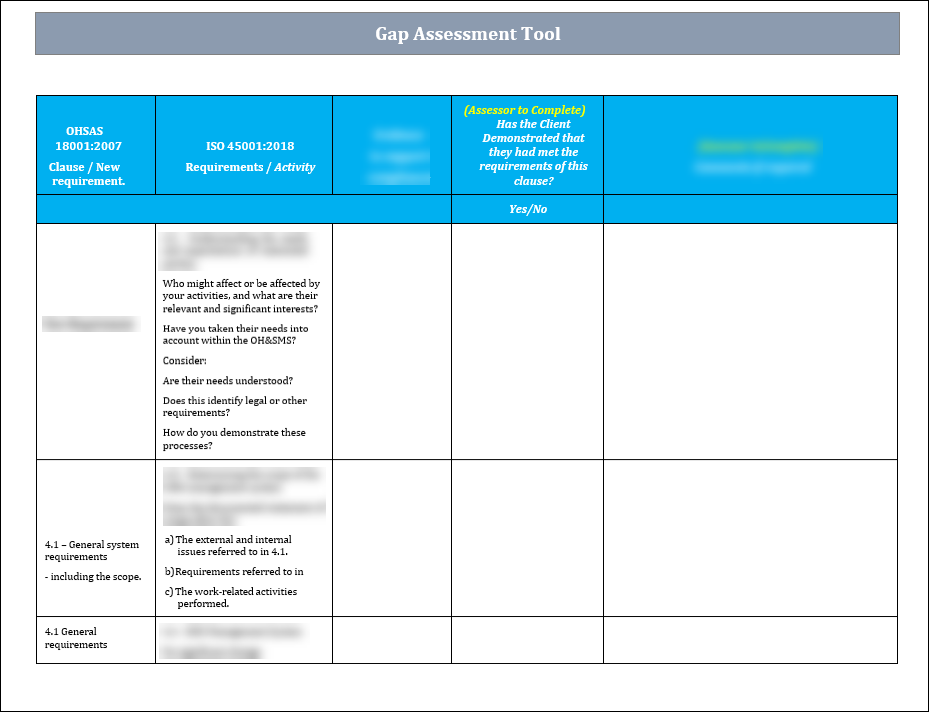ISO 45001 Gap Assessment Tool Template
Introduction
Implementing and maintaining an effective Occupational Health and Safety Management System (OHSMS) is crucial for organizations to ensure the well-being of their employees and comply with legal requirements. A comprehensive Gap Assessment Tool for the ISO 45001 Template can be a valuable resource for this process. This tool helps organizations identify areas of improvement, compliance gaps, and potential risks with ISO 45001 standards. Organizations can streamline their OHSMS implementation and certification process by utilizing this template.

Understanding The Excel Implementation Plan Template For ISO 45001
Conducting a gap assessment for ISO 45001 compliance is essential for several reasons:
1. Identify Areas Of Non-compliance: A gap assessment helps to pinpoint areas where your organization does not meet the requirements of the ISO 45001 standard. This allows you to address these gaps and make the necessary improvements to achieve compliance.
2. Mitigate Risks: By conducting a gap assessment, you can identify potential risks and hazards in your occupational health and safety management system. This enables you to take proactive measures to mitigate these risks and create a safer work environment for your employees.
3. Ensure Legal Compliance: ISO 45001 is designed to help organizations comply with occupational health and safety regulations. By conducting a gap assessment, you can ensure that your organization meets legal requirements and avoids potential penalties or fines.
4. Improve Performance: The ISO 45001 standard focuses on improving health and safety performance. By conducting a gap assessment, you can identify opportunities to enhance your occupational health and safety management system and improve overall performance.
5. Enhance Reputation: Achieving ISO 45001 compliance demonstrates to stakeholders, customers, and employees that your organization is committed to providing a safe and healthy workplace. This can enhance your reputation, attract new business opportunities, and improve employee morale.
Features Of The Gap Assessment Tool Template
1. Easy-to-use Interface: The Gap Assessment Tool template has a user-friendly design that makes it easy for users to navigate and input information.
2. Customizable Fields: Users can personalize the template by adding or removing fields to suit their needs and requirements.
3. Detailed Analysis: The template is designed to provide a comprehensive evaluation of the gaps between current and desired states, helping users identify improvement areas.
4. Actionable Recommendations: The Gap Assessment Tool template generates practical recommendations and action plans to help users bridge the identified gaps.
5. Track Progress: The template allows users to track the progress of their gap assessment over time, helping them monitor improvements and adjust strategies as needed.
6. Data Visualization: The template uses graphs and charts to represent the gap assessment results visually, making it easier for users to interpret and communicate findings.
7. Collaboration Features: The template allows multiple users to work on the assessment simultaneously, making it ideal for team-based projects.
8. Save and Export Capabilities: Users can save their work in the template and export it in various formats, such as PDF or Excel, for further analysis and sharing with stakeholders.

Benefits Of Using A Structured Gap Assessment Tool
1. Systematic Evaluation: A structured gap assessment tool provides a systematic approach to identifying gaps in learning and proficiency. This allows for a thorough evaluation of the areas that need improvement.
2. Tailored Learning Plan: A structured gap assessment tool can help create a tailored learning plan for individuals or groups by identifying specific gaps in knowledge and skills. This ensures that learning objectives are focused on addressing areas of weakness.
3. Measurable Progress: Progress can be measured over time using a structured gap assessment tool. This helps track improvement and adjust learning strategies as needed.
4. Increased Motivation: Knowing specific areas that need improvement can increase motivation to learn and practice. A structured gap assessment tool can help set achievable goals and benchmarks for progress.
5. Enhanced Communication: By addressing specific gaps in communication skills, individuals can improve their ability to communicate effectively, which can lead to better academic and professional opportunities.
6. Personalized Feedback: A structured gap assessment tool can provide personalized feedback on areas of strength and weakness. This can help individuals focus on improving areas that need more attention.
7. Confidence Building: Identifying and addressing proficiency gaps can boost confidence in language use. Individuals can feel more comfortable and proficient by working on specific areas of weakness.
Conclusion
In conclusion, utilizing a comprehensive Gap Assessment Tool for ISO 45001 is crucial for organizations aiming to achieve compliance with occupational health and safety standards. This template provides a structured approach to identify areas of improvement and ensure alignment with ISO 45001 requirements. Implementing this tool will streamline the compliance process and enhance workplace safety and overall organizational performance. Gap Assessment Tool for ISO 45001 Template today to drive continuous improvement in your occupational health and safety management system.


